Advanced Cancer Immunotherapy: PD1 and PDL1 Pathways and Treatments
VerifiedAdded on 2022/04/14
|11
|2957
|39
Report
AI Summary
This report provides a comprehensive overview of PD1 and PDL1 cancer immunotherapy, a critical area in modern cancer treatment. It begins by explaining the PD1 and PDL1 pathway, emphasizing the role of the body's immune system in eliminating unhealthy cells and how cancer cells evade this process. The report then delves into the role of PD1 and PDL1 in cancer, detailing how these proteins compromise the activity of T-cells, leading to immune suppression and tumor evasion. Various cancer immunotherapy approaches are discussed, including the use of monoclonal antibodies like Nivolumab and Pembrolizumab, combination immunotherapies, and adoptive T-cell therapy, including CAR T-cell therapy. The report also covers cancer vaccines and their mechanisms in activating the immune system to attack tumor cells. Overall, the report provides a detailed analysis of the mechanisms, treatments, and advancements in PD1 and PDL1 cancer immunotherapy.
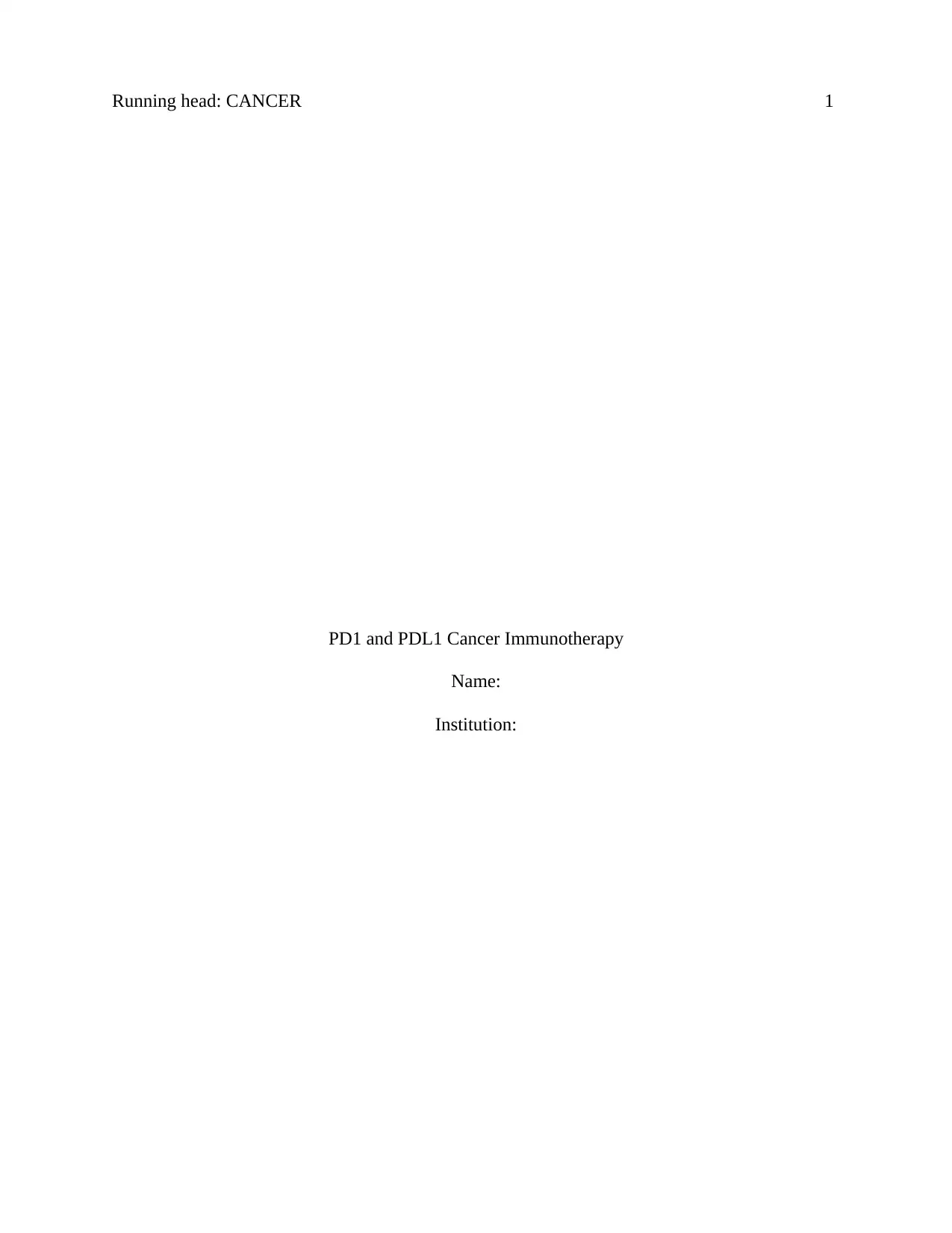
Running head: CANCER 1
PD1 and PDL1 Cancer Immunotherapy
Name:
Institution:
PD1 and PDL1 Cancer Immunotherapy
Name:
Institution:
Paraphrase This Document
Need a fresh take? Get an instant paraphrase of this document with our AI Paraphraser
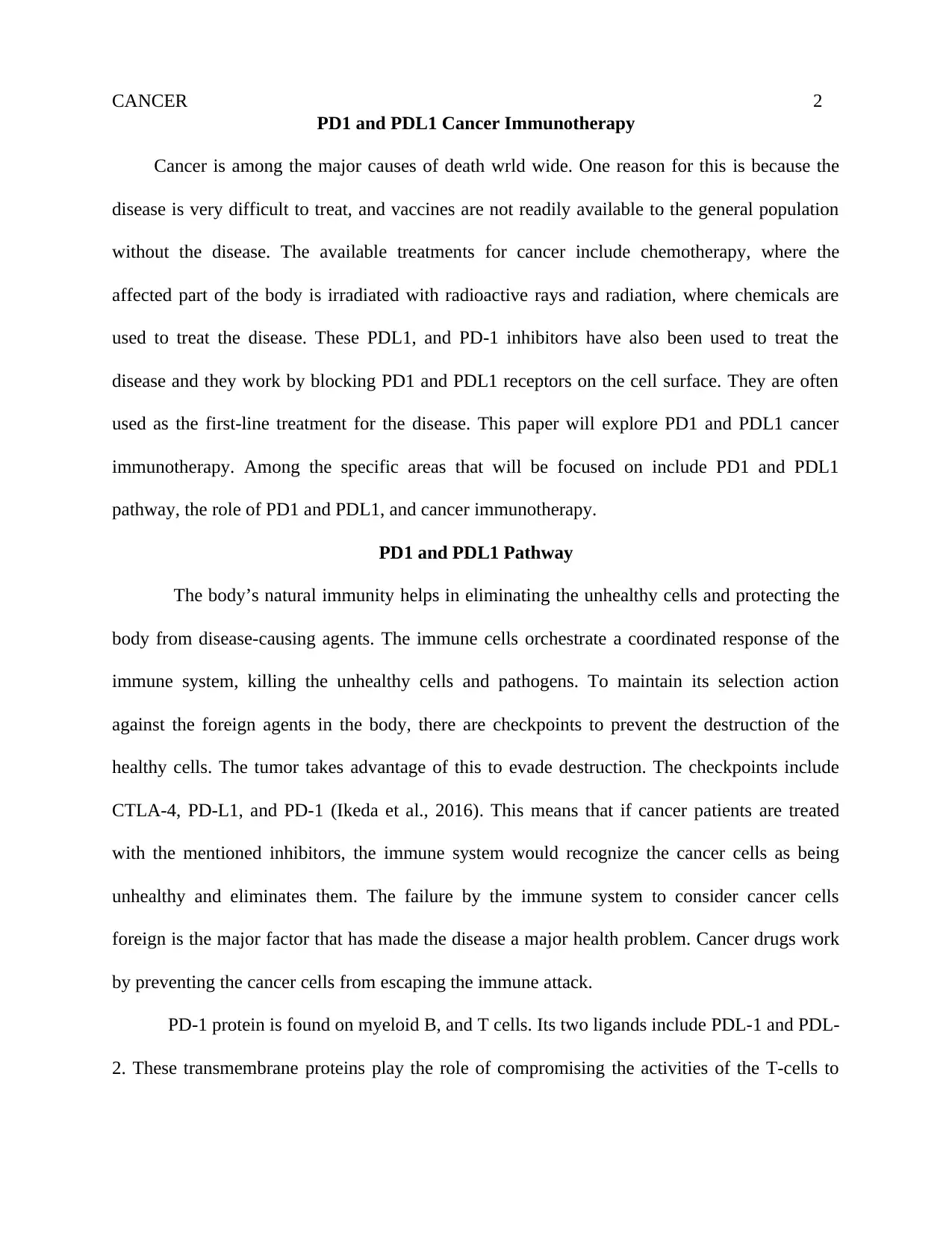
CANCER 2
PD1 and PDL1 Cancer Immunotherapy
Cancer is among the major causes of death wrld wide. One reason for this is because the
disease is very difficult to treat, and vaccines are not readily available to the general population
without the disease. The available treatments for cancer include chemotherapy, where the
affected part of the body is irradiated with radioactive rays and radiation, where chemicals are
used to treat the disease. These PDL1, and PD-1 inhibitors have also been used to treat the
disease and they work by blocking PD1 and PDL1 receptors on the cell surface. They are often
used as the first-line treatment for the disease. This paper will explore PD1 and PDL1 cancer
immunotherapy. Among the specific areas that will be focused on include PD1 and PDL1
pathway, the role of PD1 and PDL1, and cancer immunotherapy.
PD1 and PDL1 Pathway
The body’s natural immunity helps in eliminating the unhealthy cells and protecting the
body from disease-causing agents. The immune cells orchestrate a coordinated response of the
immune system, killing the unhealthy cells and pathogens. To maintain its selection action
against the foreign agents in the body, there are checkpoints to prevent the destruction of the
healthy cells. The tumor takes advantage of this to evade destruction. The checkpoints include
CTLA-4, PD-L1, and PD-1 (Ikeda et al., 2016). This means that if cancer patients are treated
with the mentioned inhibitors, the immune system would recognize the cancer cells as being
unhealthy and eliminates them. The failure by the immune system to consider cancer cells
foreign is the major factor that has made the disease a major health problem. Cancer drugs work
by preventing the cancer cells from escaping the immune attack.
PD-1 protein is found on myeloid B, and T cells. Its two ligands include PDL-1 and PDL-
2. These transmembrane proteins play the role of compromising the activities of the T-cells to
PD1 and PDL1 Cancer Immunotherapy
Cancer is among the major causes of death wrld wide. One reason for this is because the
disease is very difficult to treat, and vaccines are not readily available to the general population
without the disease. The available treatments for cancer include chemotherapy, where the
affected part of the body is irradiated with radioactive rays and radiation, where chemicals are
used to treat the disease. These PDL1, and PD-1 inhibitors have also been used to treat the
disease and they work by blocking PD1 and PDL1 receptors on the cell surface. They are often
used as the first-line treatment for the disease. This paper will explore PD1 and PDL1 cancer
immunotherapy. Among the specific areas that will be focused on include PD1 and PDL1
pathway, the role of PD1 and PDL1, and cancer immunotherapy.
PD1 and PDL1 Pathway
The body’s natural immunity helps in eliminating the unhealthy cells and protecting the
body from disease-causing agents. The immune cells orchestrate a coordinated response of the
immune system, killing the unhealthy cells and pathogens. To maintain its selection action
against the foreign agents in the body, there are checkpoints to prevent the destruction of the
healthy cells. The tumor takes advantage of this to evade destruction. The checkpoints include
CTLA-4, PD-L1, and PD-1 (Ikeda et al., 2016). This means that if cancer patients are treated
with the mentioned inhibitors, the immune system would recognize the cancer cells as being
unhealthy and eliminates them. The failure by the immune system to consider cancer cells
foreign is the major factor that has made the disease a major health problem. Cancer drugs work
by preventing the cancer cells from escaping the immune attack.
PD-1 protein is found on myeloid B, and T cells. Its two ligands include PDL-1 and PDL-
2. These transmembrane proteins play the role of compromising the activities of the T-cells to
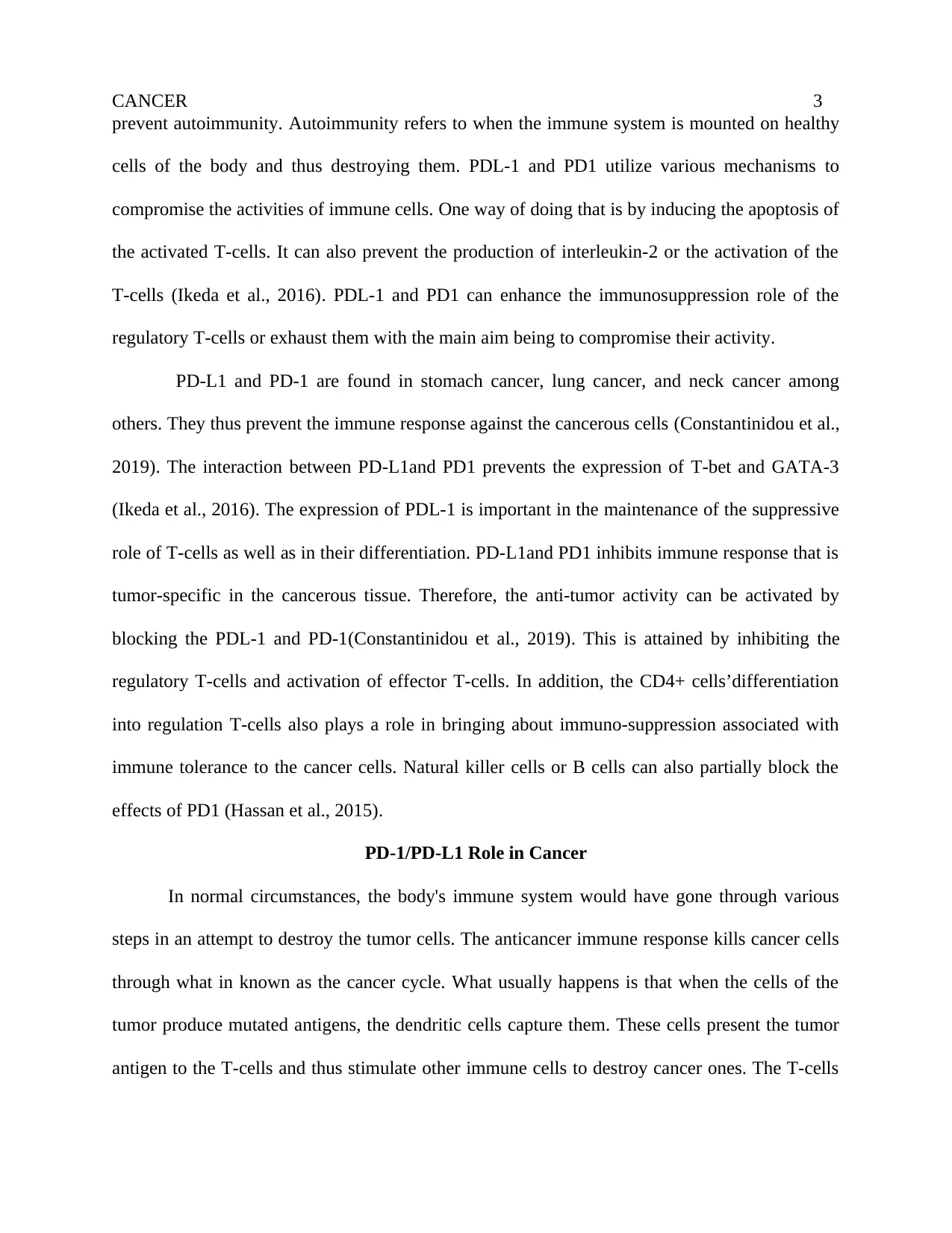
CANCER 3
prevent autoimmunity. Autoimmunity refers to when the immune system is mounted on healthy
cells of the body and thus destroying them. PDL-1 and PD1 utilize various mechanisms to
compromise the activities of immune cells. One way of doing that is by inducing the apoptosis of
the activated T-cells. It can also prevent the production of interleukin-2 or the activation of the
T-cells (Ikeda et al., 2016). PDL-1 and PD1 can enhance the immunosuppression role of the
regulatory T-cells or exhaust them with the main aim being to compromise their activity.
PD-L1 and PD-1 are found in stomach cancer, lung cancer, and neck cancer among
others. They thus prevent the immune response against the cancerous cells (Constantinidou et al.,
2019). The interaction between PD-L1and PD1 prevents the expression of T-bet and GATA-3
(Ikeda et al., 2016). The expression of PDL-1 is important in the maintenance of the suppressive
role of T-cells as well as in their differentiation. PD-L1and PD1 inhibits immune response that is
tumor-specific in the cancerous tissue. Therefore, the anti-tumor activity can be activated by
blocking the PDL-1 and PD-1(Constantinidou et al., 2019). This is attained by inhibiting the
regulatory T-cells and activation of effector T-cells. In addition, the CD4+ cells’differentiation
into regulation T-cells also plays a role in bringing about immuno-suppression associated with
immune tolerance to the cancer cells. Natural killer cells or B cells can also partially block the
effects of PD1 (Hassan et al., 2015).
PD-1/PD-L1 Role in Cancer
In normal circumstances, the body's immune system would have gone through various
steps in an attempt to destroy the tumor cells. The anticancer immune response kills cancer cells
through what in known as the cancer cycle. What usually happens is that when the cells of the
tumor produce mutated antigens, the dendritic cells capture them. These cells present the tumor
antigen to the T-cells and thus stimulate other immune cells to destroy cancer ones. The T-cells
prevent autoimmunity. Autoimmunity refers to when the immune system is mounted on healthy
cells of the body and thus destroying them. PDL-1 and PD1 utilize various mechanisms to
compromise the activities of immune cells. One way of doing that is by inducing the apoptosis of
the activated T-cells. It can also prevent the production of interleukin-2 or the activation of the
T-cells (Ikeda et al., 2016). PDL-1 and PD1 can enhance the immunosuppression role of the
regulatory T-cells or exhaust them with the main aim being to compromise their activity.
PD-L1 and PD-1 are found in stomach cancer, lung cancer, and neck cancer among
others. They thus prevent the immune response against the cancerous cells (Constantinidou et al.,
2019). The interaction between PD-L1and PD1 prevents the expression of T-bet and GATA-3
(Ikeda et al., 2016). The expression of PDL-1 is important in the maintenance of the suppressive
role of T-cells as well as in their differentiation. PD-L1and PD1 inhibits immune response that is
tumor-specific in the cancerous tissue. Therefore, the anti-tumor activity can be activated by
blocking the PDL-1 and PD-1(Constantinidou et al., 2019). This is attained by inhibiting the
regulatory T-cells and activation of effector T-cells. In addition, the CD4+ cells’differentiation
into regulation T-cells also plays a role in bringing about immuno-suppression associated with
immune tolerance to the cancer cells. Natural killer cells or B cells can also partially block the
effects of PD1 (Hassan et al., 2015).
PD-1/PD-L1 Role in Cancer
In normal circumstances, the body's immune system would have gone through various
steps in an attempt to destroy the tumor cells. The anticancer immune response kills cancer cells
through what in known as the cancer cycle. What usually happens is that when the cells of the
tumor produce mutated antigens, the dendritic cells capture them. These cells present the tumor
antigen to the T-cells and thus stimulate other immune cells to destroy cancer ones. The T-cells
⊘ This is a preview!⊘
Do you want full access?
Subscribe today to unlock all pages.

Trusted by 1+ million students worldwide
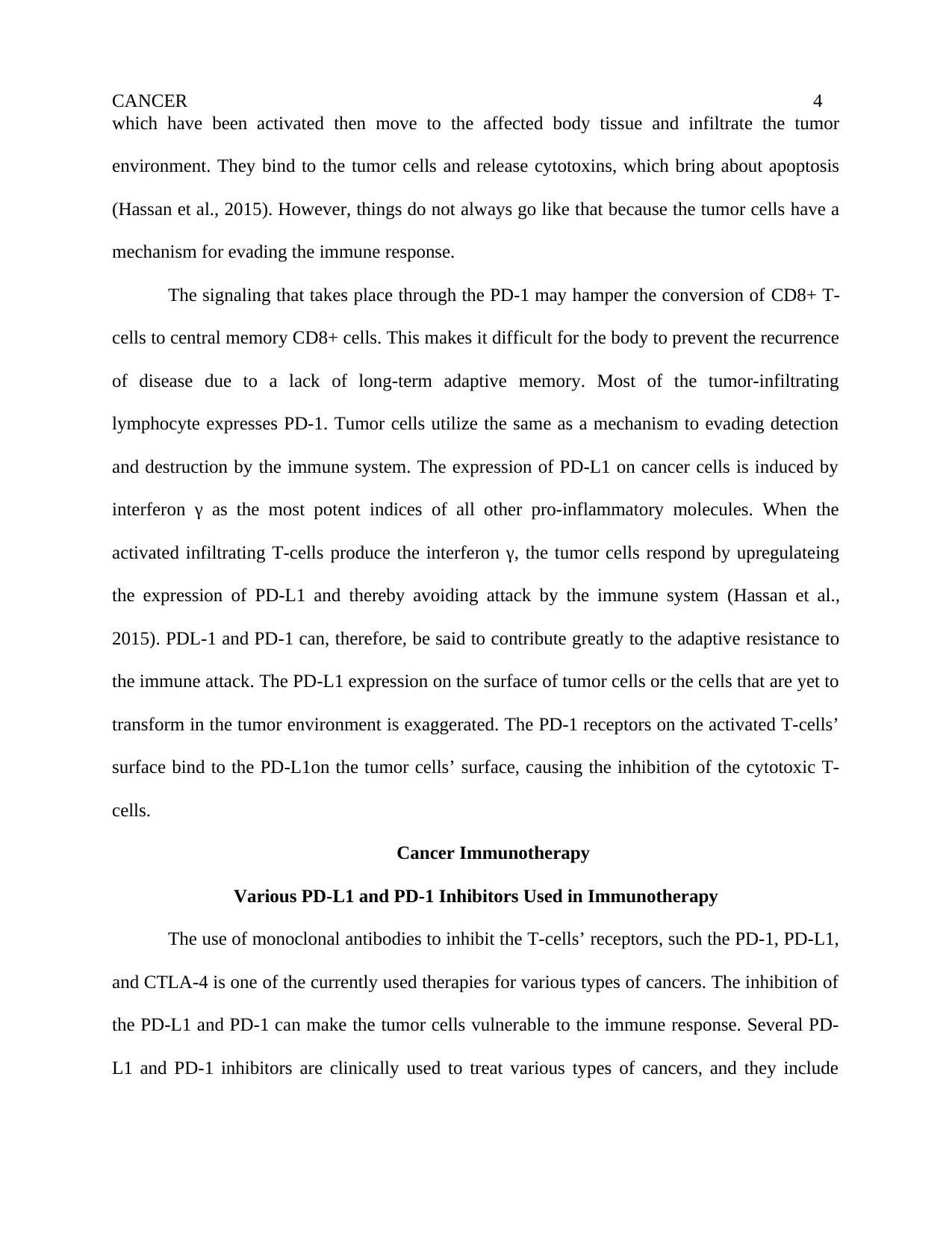
CANCER 4
which have been activated then move to the affected body tissue and infiltrate the tumor
environment. They bind to the tumor cells and release cytotoxins, which bring about apoptosis
(Hassan et al., 2015). However, things do not always go like that because the tumor cells have a
mechanism for evading the immune response.
The signaling that takes place through the PD-1 may hamper the conversion of CD8+ T-
cells to central memory CD8+ cells. This makes it difficult for the body to prevent the recurrence
of disease due to a lack of long-term adaptive memory. Most of the tumor-infiltrating
lymphocyte expresses PD-1. Tumor cells utilize the same as a mechanism to evading detection
and destruction by the immune system. The expression of PD-L1 on cancer cells is induced by
interferon γ as the most potent indices of all other pro-inflammatory molecules. When the
activated infiltrating T-cells produce the interferon γ, the tumor cells respond by upregulateing
the expression of PD-L1 and thereby avoiding attack by the immune system (Hassan et al.,
2015). PDL-1 and PD-1 can, therefore, be said to contribute greatly to the adaptive resistance to
the immune attack. The PD-L1 expression on the surface of tumor cells or the cells that are yet to
transform in the tumor environment is exaggerated. The PD-1 receptors on the activated T-cells’
surface bind to the PD-L1on the tumor cells’ surface, causing the inhibition of the cytotoxic T-
cells.
Cancer Immunotherapy
Various PD-L1 and PD-1 Inhibitors Used in Immunotherapy
The use of monoclonal antibodies to inhibit the T-cells’ receptors, such the PD-1, PD-L1,
and CTLA-4 is one of the currently used therapies for various types of cancers. The inhibition of
the PD-L1 and PD-1 can make the tumor cells vulnerable to the immune response. Several PD-
L1 and PD-1 inhibitors are clinically used to treat various types of cancers, and they include
which have been activated then move to the affected body tissue and infiltrate the tumor
environment. They bind to the tumor cells and release cytotoxins, which bring about apoptosis
(Hassan et al., 2015). However, things do not always go like that because the tumor cells have a
mechanism for evading the immune response.
The signaling that takes place through the PD-1 may hamper the conversion of CD8+ T-
cells to central memory CD8+ cells. This makes it difficult for the body to prevent the recurrence
of disease due to a lack of long-term adaptive memory. Most of the tumor-infiltrating
lymphocyte expresses PD-1. Tumor cells utilize the same as a mechanism to evading detection
and destruction by the immune system. The expression of PD-L1 on cancer cells is induced by
interferon γ as the most potent indices of all other pro-inflammatory molecules. When the
activated infiltrating T-cells produce the interferon γ, the tumor cells respond by upregulateing
the expression of PD-L1 and thereby avoiding attack by the immune system (Hassan et al.,
2015). PDL-1 and PD-1 can, therefore, be said to contribute greatly to the adaptive resistance to
the immune attack. The PD-L1 expression on the surface of tumor cells or the cells that are yet to
transform in the tumor environment is exaggerated. The PD-1 receptors on the activated T-cells’
surface bind to the PD-L1on the tumor cells’ surface, causing the inhibition of the cytotoxic T-
cells.
Cancer Immunotherapy
Various PD-L1 and PD-1 Inhibitors Used in Immunotherapy
The use of monoclonal antibodies to inhibit the T-cells’ receptors, such the PD-1, PD-L1,
and CTLA-4 is one of the currently used therapies for various types of cancers. The inhibition of
the PD-L1 and PD-1 can make the tumor cells vulnerable to the immune response. Several PD-
L1 and PD-1 inhibitors are clinically used to treat various types of cancers, and they include
Paraphrase This Document
Need a fresh take? Get an instant paraphrase of this document with our AI Paraphraser

CANCER 5
Nivolumab, Ipilimumab Pembrolizumab, Atezolizumab, and Dulvalumab. Nivolumab and
Pembrolizumab are PD-1 inhibitors and consist of monoclonal antibodies that target the tumor
cells. Atezolizumab and Dulvalumab target the PD-L1 and have been proven successful in
preventing lung cancer. Pembrolizumab is a PD-L1 inhibitor manufactured by Merck, and that is
used to treat melanoma Ipilimumab inhibits the effects of CTLA-4 in preventing the cytotoxic T-
cells from mounting immune response of tumor cells (Hellmann et al., 2018).
Combination immunotherapy
Although the use of monoclonal antibodies in blocking the checkpoints has proven
efficient in cancer treatment, a single therapy may not work on all patients. Doctors enhance the
effectiveness of cancer treatment by combining more than one therapy. The combination of
CTLA-4, PD-L1, and PD-1, has proven successful in treating cancer. Treatment with a single
checkpoint inhibitor has been found to be between 20% and 40% effective in treating advanced
melanoma (Larkin et al., 2015). A single therapy focuses only on one receptor while combined
therapy inhibits all.
Studies are being carried out to look for the possibilities of combining the checkpoint
blockade with other types of therapies such as surgery, chemotherapy, targeted therapy,
radiation, vaccines, T-cell transfer, T-cell stimulatory agents, and vaccines to minimize toxicity
and increase the durability of the immunity against the cancer cells (Hellmann et al., 2018).
However, it is not possible to know if these combinations will have a redundant effect or
synergistic effect in the treatment of cancer due to a lack of clear understanding their detailed
mechanism of action (Jiang et al., 2019). Some of the issues that need to be addressed before the
application of these combination strategies include first coming up with the method of delivery
to avoid the problems associated with the overstimulation of the immune system and having a
Nivolumab, Ipilimumab Pembrolizumab, Atezolizumab, and Dulvalumab. Nivolumab and
Pembrolizumab are PD-1 inhibitors and consist of monoclonal antibodies that target the tumor
cells. Atezolizumab and Dulvalumab target the PD-L1 and have been proven successful in
preventing lung cancer. Pembrolizumab is a PD-L1 inhibitor manufactured by Merck, and that is
used to treat melanoma Ipilimumab inhibits the effects of CTLA-4 in preventing the cytotoxic T-
cells from mounting immune response of tumor cells (Hellmann et al., 2018).
Combination immunotherapy
Although the use of monoclonal antibodies in blocking the checkpoints has proven
efficient in cancer treatment, a single therapy may not work on all patients. Doctors enhance the
effectiveness of cancer treatment by combining more than one therapy. The combination of
CTLA-4, PD-L1, and PD-1, has proven successful in treating cancer. Treatment with a single
checkpoint inhibitor has been found to be between 20% and 40% effective in treating advanced
melanoma (Larkin et al., 2015). A single therapy focuses only on one receptor while combined
therapy inhibits all.
Studies are being carried out to look for the possibilities of combining the checkpoint
blockade with other types of therapies such as surgery, chemotherapy, targeted therapy,
radiation, vaccines, T-cell transfer, T-cell stimulatory agents, and vaccines to minimize toxicity
and increase the durability of the immunity against the cancer cells (Hellmann et al., 2018).
However, it is not possible to know if these combinations will have a redundant effect or
synergistic effect in the treatment of cancer due to a lack of clear understanding their detailed
mechanism of action (Jiang et al., 2019). Some of the issues that need to be addressed before the
application of these combination strategies include first coming up with the method of delivery
to avoid the problems associated with the overstimulation of the immune system and having a
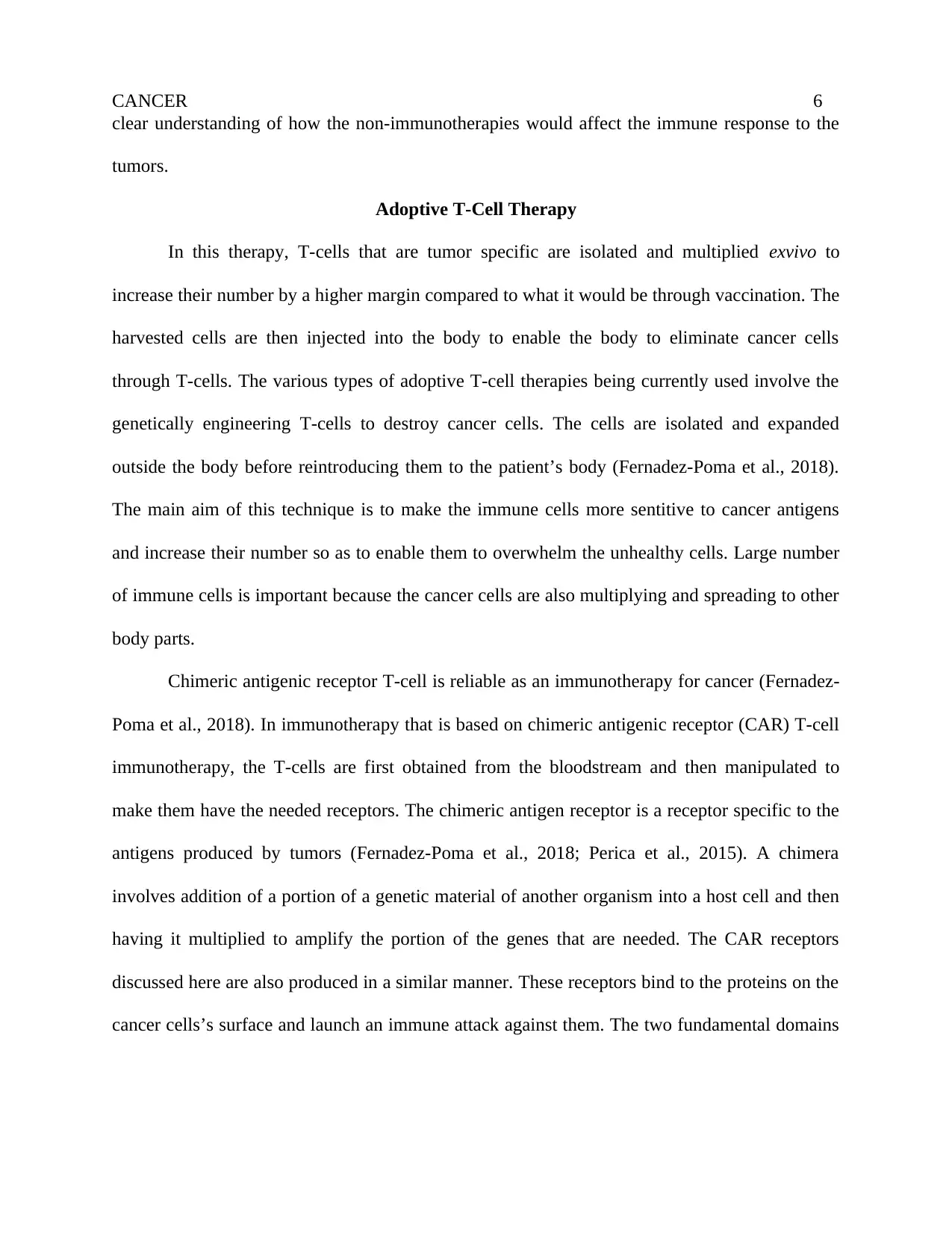
CANCER 6
clear understanding of how the non-immunotherapies would affect the immune response to the
tumors.
Adoptive T-Cell Therapy
In this therapy, T-cells that are tumor specific are isolated and multiplied exvivo to
increase their number by a higher margin compared to what it would be through vaccination. The
harvested cells are then injected into the body to enable the body to eliminate cancer cells
through T-cells. The various types of adoptive T-cell therapies being currently used involve the
genetically engineering T-cells to destroy cancer cells. The cells are isolated and expanded
outside the body before reintroducing them to the patient’s body (Fernadez-Poma et al., 2018).
The main aim of this technique is to make the immune cells more sentitive to cancer antigens
and increase their number so as to enable them to overwhelm the unhealthy cells. Large number
of immune cells is important because the cancer cells are also multiplying and spreading to other
body parts.
Chimeric antigenic receptor T-cell is reliable as an immunotherapy for cancer (Fernadez-
Poma et al., 2018). In immunotherapy that is based on chimeric antigenic receptor (CAR) T-cell
immunotherapy, the T-cells are first obtained from the bloodstream and then manipulated to
make them have the needed receptors. The chimeric antigen receptor is a receptor specific to the
antigens produced by tumors (Fernadez-Poma et al., 2018; Perica et al., 2015). A chimera
involves addition of a portion of a genetic material of another organism into a host cell and then
having it multiplied to amplify the portion of the genes that are needed. The CAR receptors
discussed here are also produced in a similar manner. These receptors bind to the proteins on the
cancer cells’s surface and launch an immune attack against them. The two fundamental domains
clear understanding of how the non-immunotherapies would affect the immune response to the
tumors.
Adoptive T-Cell Therapy
In this therapy, T-cells that are tumor specific are isolated and multiplied exvivo to
increase their number by a higher margin compared to what it would be through vaccination. The
harvested cells are then injected into the body to enable the body to eliminate cancer cells
through T-cells. The various types of adoptive T-cell therapies being currently used involve the
genetically engineering T-cells to destroy cancer cells. The cells are isolated and expanded
outside the body before reintroducing them to the patient’s body (Fernadez-Poma et al., 2018).
The main aim of this technique is to make the immune cells more sentitive to cancer antigens
and increase their number so as to enable them to overwhelm the unhealthy cells. Large number
of immune cells is important because the cancer cells are also multiplying and spreading to other
body parts.
Chimeric antigenic receptor T-cell is reliable as an immunotherapy for cancer (Fernadez-
Poma et al., 2018). In immunotherapy that is based on chimeric antigenic receptor (CAR) T-cell
immunotherapy, the T-cells are first obtained from the bloodstream and then manipulated to
make them have the needed receptors. The chimeric antigen receptor is a receptor specific to the
antigens produced by tumors (Fernadez-Poma et al., 2018; Perica et al., 2015). A chimera
involves addition of a portion of a genetic material of another organism into a host cell and then
having it multiplied to amplify the portion of the genes that are needed. The CAR receptors
discussed here are also produced in a similar manner. These receptors bind to the proteins on the
cancer cells’s surface and launch an immune attack against them. The two fundamental domains
⊘ This is a preview!⊘
Do you want full access?
Subscribe today to unlock all pages.

Trusted by 1+ million students worldwide

CANCER 7
of these receptors include the portion that binds to the antigen and signaling domains of the T-
cell (Fernadez-Poma et al., 2018).
Among the characteristics of the tumor cells antigens that are a target for CAR T-cells
include that the antigents are not present in other cells, they affect the survival of the tumor cells,
they are on the tumor cells’s surface, and are present in all cancer stem cells and tumor cells. In
other words, these antigens are not found in other types of cells except the cancer cells. They
affect the survival of the tumor cells because they are the one targeted to by the immune system.
These characteristics are unique to tumor cells, a factor that exposes them to selective killing by
the immune cells. The T-cell activation can be enhanced by adding extra domains in the CAR.
The most commonly added ones are 4-1Bb and CD 28 costimulatory signaling domains
(Fernadez-Poma et al., 2018). To enhance the efficacy of the therapy, CAR T-cells have to show
enduring anti-tumor cytotoxicity, persist, expand, overcome the evasion of the target tumor
antigen, and counteract the immunosuppressive microenvironment of the tumor. All these factors
must be harmonized when designing the CAR T-cells to ensure that they generate an optimal
effect. This means that the CAR T-cells should possess all these characteristics to enable them
fight the cancer cells effectively.
Vaccines
Vaccines are also developed to help the body get rid of tumors. It is important to note that
while the vaccines are usually meant to prevent infection, cancer vaccines are meant to treat the
disease rather than to prevent it. The vaccines are aimed at making the body more immunogenic
through activation of the immune system. The vaccines aim at making the immune system
mounts an attack on the tumor cells. The cancer vaccines can be made of different elements,
including pure antigens constituting of certain proteins from the tumor cells, parts of the cell, as
of these receptors include the portion that binds to the antigen and signaling domains of the T-
cell (Fernadez-Poma et al., 2018).
Among the characteristics of the tumor cells antigens that are a target for CAR T-cells
include that the antigents are not present in other cells, they affect the survival of the tumor cells,
they are on the tumor cells’s surface, and are present in all cancer stem cells and tumor cells. In
other words, these antigens are not found in other types of cells except the cancer cells. They
affect the survival of the tumor cells because they are the one targeted to by the immune system.
These characteristics are unique to tumor cells, a factor that exposes them to selective killing by
the immune cells. The T-cell activation can be enhanced by adding extra domains in the CAR.
The most commonly added ones are 4-1Bb and CD 28 costimulatory signaling domains
(Fernadez-Poma et al., 2018). To enhance the efficacy of the therapy, CAR T-cells have to show
enduring anti-tumor cytotoxicity, persist, expand, overcome the evasion of the target tumor
antigen, and counteract the immunosuppressive microenvironment of the tumor. All these factors
must be harmonized when designing the CAR T-cells to ensure that they generate an optimal
effect. This means that the CAR T-cells should possess all these characteristics to enable them
fight the cancer cells effectively.
Vaccines
Vaccines are also developed to help the body get rid of tumors. It is important to note that
while the vaccines are usually meant to prevent infection, cancer vaccines are meant to treat the
disease rather than to prevent it. The vaccines are aimed at making the body more immunogenic
through activation of the immune system. The vaccines aim at making the immune system
mounts an attack on the tumor cells. The cancer vaccines can be made of different elements,
including pure antigens constituting of certain proteins from the tumor cells, parts of the cell, as
Paraphrase This Document
Need a fresh take? Get an instant paraphrase of this document with our AI Paraphraser
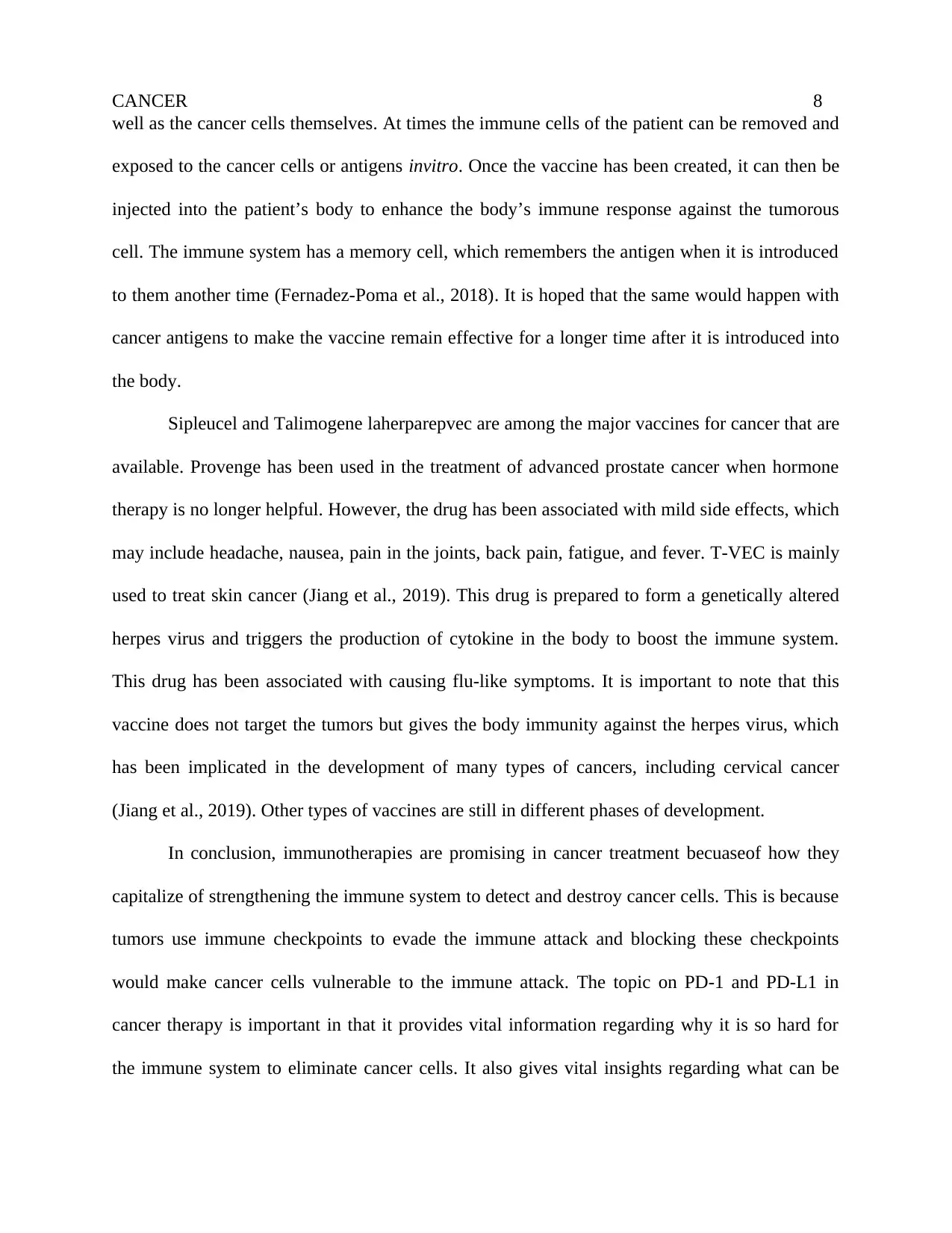
CANCER 8
well as the cancer cells themselves. At times the immune cells of the patient can be removed and
exposed to the cancer cells or antigens invitro. Once the vaccine has been created, it can then be
injected into the patient’s body to enhance the body’s immune response against the tumorous
cell. The immune system has a memory cell, which remembers the antigen when it is introduced
to them another time (Fernadez-Poma et al., 2018). It is hoped that the same would happen with
cancer antigens to make the vaccine remain effective for a longer time after it is introduced into
the body.
Sipleucel and Talimogene laherparepvec are among the major vaccines for cancer that are
available. Provenge has been used in the treatment of advanced prostate cancer when hormone
therapy is no longer helpful. However, the drug has been associated with mild side effects, which
may include headache, nausea, pain in the joints, back pain, fatigue, and fever. T-VEC is mainly
used to treat skin cancer (Jiang et al., 2019). This drug is prepared to form a genetically altered
herpes virus and triggers the production of cytokine in the body to boost the immune system.
This drug has been associated with causing flu-like symptoms. It is important to note that this
vaccine does not target the tumors but gives the body immunity against the herpes virus, which
has been implicated in the development of many types of cancers, including cervical cancer
(Jiang et al., 2019). Other types of vaccines are still in different phases of development.
In conclusion, immunotherapies are promising in cancer treatment becuaseof how they
capitalize of strengthening the immune system to detect and destroy cancer cells. This is because
tumors use immune checkpoints to evade the immune attack and blocking these checkpoints
would make cancer cells vulnerable to the immune attack. The topic on PD-1 and PD-L1 in
cancer therapy is important in that it provides vital information regarding why it is so hard for
the immune system to eliminate cancer cells. It also gives vital insights regarding what can be
well as the cancer cells themselves. At times the immune cells of the patient can be removed and
exposed to the cancer cells or antigens invitro. Once the vaccine has been created, it can then be
injected into the patient’s body to enhance the body’s immune response against the tumorous
cell. The immune system has a memory cell, which remembers the antigen when it is introduced
to them another time (Fernadez-Poma et al., 2018). It is hoped that the same would happen with
cancer antigens to make the vaccine remain effective for a longer time after it is introduced into
the body.
Sipleucel and Talimogene laherparepvec are among the major vaccines for cancer that are
available. Provenge has been used in the treatment of advanced prostate cancer when hormone
therapy is no longer helpful. However, the drug has been associated with mild side effects, which
may include headache, nausea, pain in the joints, back pain, fatigue, and fever. T-VEC is mainly
used to treat skin cancer (Jiang et al., 2019). This drug is prepared to form a genetically altered
herpes virus and triggers the production of cytokine in the body to boost the immune system.
This drug has been associated with causing flu-like symptoms. It is important to note that this
vaccine does not target the tumors but gives the body immunity against the herpes virus, which
has been implicated in the development of many types of cancers, including cervical cancer
(Jiang et al., 2019). Other types of vaccines are still in different phases of development.
In conclusion, immunotherapies are promising in cancer treatment becuaseof how they
capitalize of strengthening the immune system to detect and destroy cancer cells. This is because
tumors use immune checkpoints to evade the immune attack and blocking these checkpoints
would make cancer cells vulnerable to the immune attack. The topic on PD-1 and PD-L1 in
cancer therapy is important in that it provides vital information regarding why it is so hard for
the immune system to eliminate cancer cells. It also gives vital insights regarding what can be

CANCER 9
done to enhance the immune system’s sensitivity to the tumor cells. However, more research
needs to be done to improve the immuno therapies and ensure that theyare available to all cancer
patients worldwide.
done to enhance the immune system’s sensitivity to the tumor cells. However, more research
needs to be done to improve the immuno therapies and ensure that theyare available to all cancer
patients worldwide.
⊘ This is a preview!⊘
Do you want full access?
Subscribe today to unlock all pages.

Trusted by 1+ million students worldwide
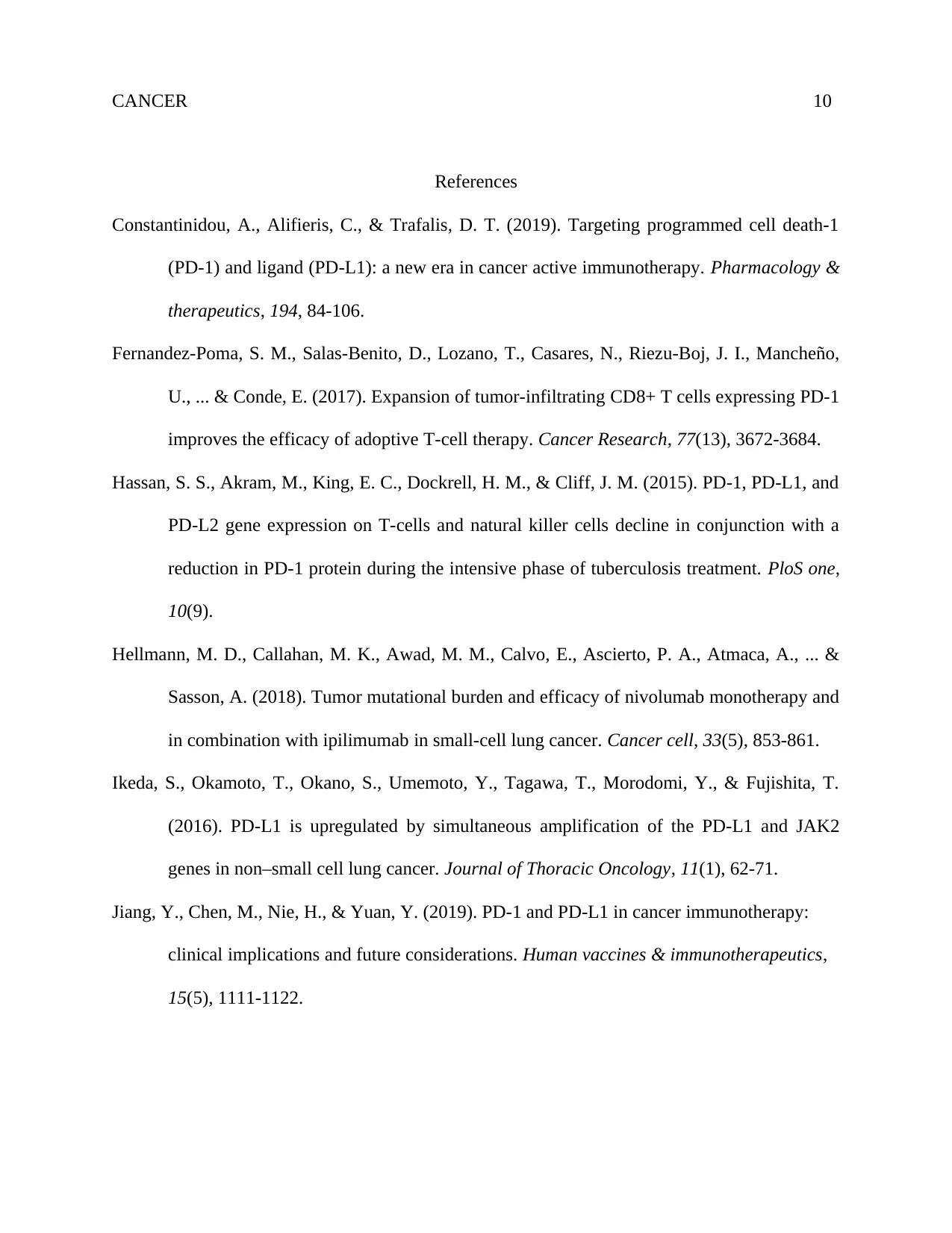
CANCER 10
References
Constantinidou, A., Alifieris, C., & Trafalis, D. T. (2019). Targeting programmed cell death-1
(PD-1) and ligand (PD-L1): a new era in cancer active immunotherapy. Pharmacology &
therapeutics, 194, 84-106.
Fernandez-Poma, S. M., Salas-Benito, D., Lozano, T., Casares, N., Riezu-Boj, J. I., Mancheño,
U., ... & Conde, E. (2017). Expansion of tumor-infiltrating CD8+ T cells expressing PD-1
improves the efficacy of adoptive T-cell therapy. Cancer Research, 77(13), 3672-3684.
Hassan, S. S., Akram, M., King, E. C., Dockrell, H. M., & Cliff, J. M. (2015). PD-1, PD-L1, and
PD-L2 gene expression on T-cells and natural killer cells decline in conjunction with a
reduction in PD-1 protein during the intensive phase of tuberculosis treatment. PloS one,
10(9).
Hellmann, M. D., Callahan, M. K., Awad, M. M., Calvo, E., Ascierto, P. A., Atmaca, A., ... &
Sasson, A. (2018). Tumor mutational burden and efficacy of nivolumab monotherapy and
in combination with ipilimumab in small-cell lung cancer. Cancer cell, 33(5), 853-861.
Ikeda, S., Okamoto, T., Okano, S., Umemoto, Y., Tagawa, T., Morodomi, Y., & Fujishita, T.
(2016). PD-L1 is upregulated by simultaneous amplification of the PD-L1 and JAK2
genes in non–small cell lung cancer. Journal of Thoracic Oncology, 11(1), 62-71.
Jiang, Y., Chen, M., Nie, H., & Yuan, Y. (2019). PD-1 and PD-L1 in cancer immunotherapy:
clinical implications and future considerations. Human vaccines & immunotherapeutics,
15(5), 1111-1122.
References
Constantinidou, A., Alifieris, C., & Trafalis, D. T. (2019). Targeting programmed cell death-1
(PD-1) and ligand (PD-L1): a new era in cancer active immunotherapy. Pharmacology &
therapeutics, 194, 84-106.
Fernandez-Poma, S. M., Salas-Benito, D., Lozano, T., Casares, N., Riezu-Boj, J. I., Mancheño,
U., ... & Conde, E. (2017). Expansion of tumor-infiltrating CD8+ T cells expressing PD-1
improves the efficacy of adoptive T-cell therapy. Cancer Research, 77(13), 3672-3684.
Hassan, S. S., Akram, M., King, E. C., Dockrell, H. M., & Cliff, J. M. (2015). PD-1, PD-L1, and
PD-L2 gene expression on T-cells and natural killer cells decline in conjunction with a
reduction in PD-1 protein during the intensive phase of tuberculosis treatment. PloS one,
10(9).
Hellmann, M. D., Callahan, M. K., Awad, M. M., Calvo, E., Ascierto, P. A., Atmaca, A., ... &
Sasson, A. (2018). Tumor mutational burden and efficacy of nivolumab monotherapy and
in combination with ipilimumab in small-cell lung cancer. Cancer cell, 33(5), 853-861.
Ikeda, S., Okamoto, T., Okano, S., Umemoto, Y., Tagawa, T., Morodomi, Y., & Fujishita, T.
(2016). PD-L1 is upregulated by simultaneous amplification of the PD-L1 and JAK2
genes in non–small cell lung cancer. Journal of Thoracic Oncology, 11(1), 62-71.
Jiang, Y., Chen, M., Nie, H., & Yuan, Y. (2019). PD-1 and PD-L1 in cancer immunotherapy:
clinical implications and future considerations. Human vaccines & immunotherapeutics,
15(5), 1111-1122.
Paraphrase This Document
Need a fresh take? Get an instant paraphrase of this document with our AI Paraphraser
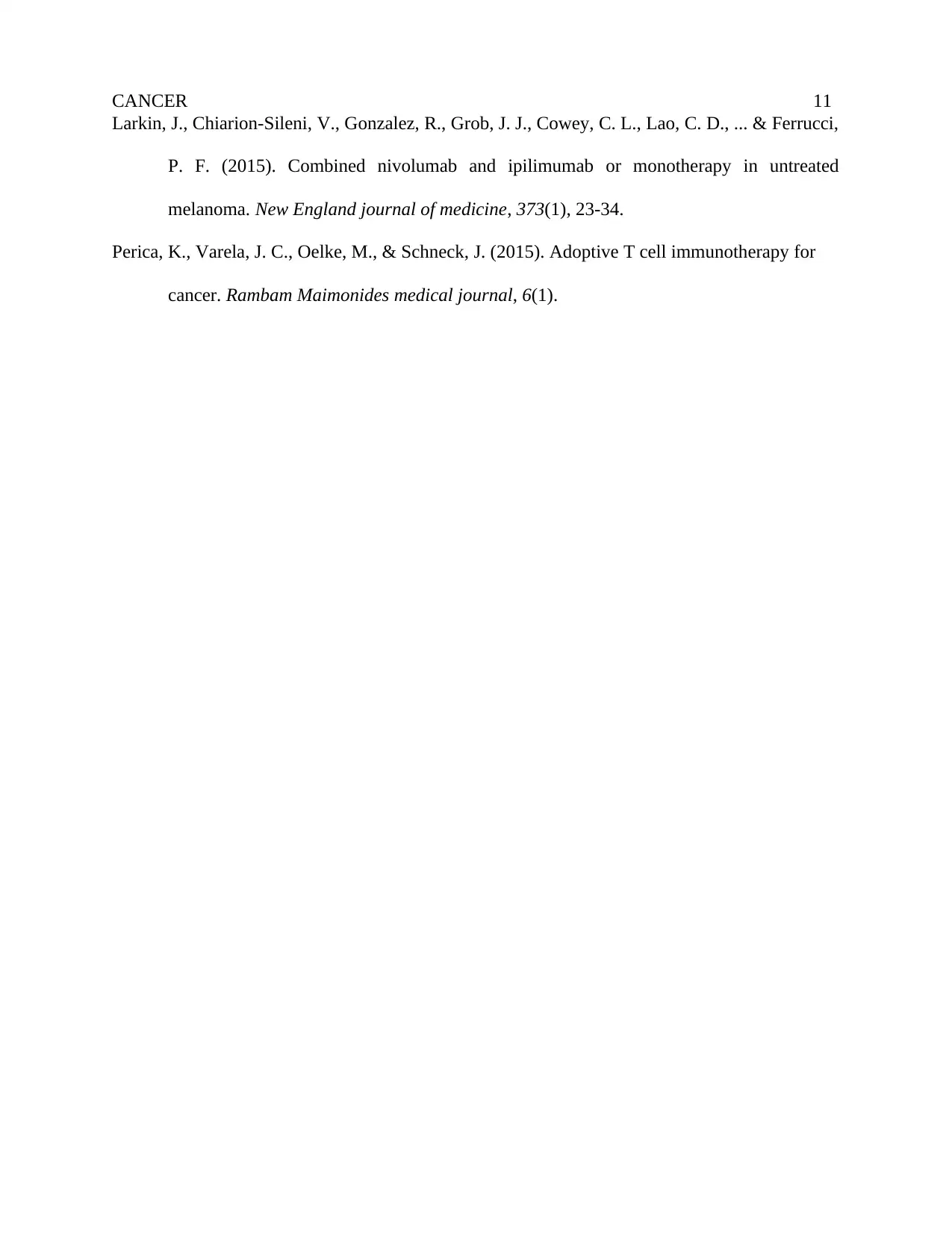
CANCER 11
Larkin, J., Chiarion-Sileni, V., Gonzalez, R., Grob, J. J., Cowey, C. L., Lao, C. D., ... & Ferrucci,
P. F. (2015). Combined nivolumab and ipilimumab or monotherapy in untreated
melanoma. New England journal of medicine, 373(1), 23-34.
Perica, K., Varela, J. C., Oelke, M., & Schneck, J. (2015). Adoptive T cell immunotherapy for
cancer. Rambam Maimonides medical journal, 6(1).
Larkin, J., Chiarion-Sileni, V., Gonzalez, R., Grob, J. J., Cowey, C. L., Lao, C. D., ... & Ferrucci,
P. F. (2015). Combined nivolumab and ipilimumab or monotherapy in untreated
melanoma. New England journal of medicine, 373(1), 23-34.
Perica, K., Varela, J. C., Oelke, M., & Schneck, J. (2015). Adoptive T cell immunotherapy for
cancer. Rambam Maimonides medical journal, 6(1).
1 out of 11
Related Documents
Your All-in-One AI-Powered Toolkit for Academic Success.
+13062052269
info@desklib.com
Available 24*7 on WhatsApp / Email
![[object Object]](/_next/static/media/star-bottom.7253800d.svg)
Unlock your academic potential
Copyright © 2020–2025 A2Z Services. All Rights Reserved. Developed and managed by ZUCOL.





